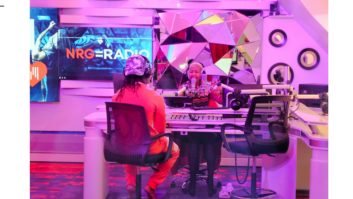HD Radio technology is not just a U.S. phenomenon.
More than 1,750 AM and FM stations in the United States are broadcasting with HD Radio technology, offering an additional 900+ new multicast channels. But there is also great interest in Latin America, Asia and parts of Europe.
In April, 2001, the International Telecommunication Union adopted Recommendation ITU-R BS.1514, which endorsed iBiquity’s AM IBOC technology for digital sound broadcasting in the broadcasting bands below 30 MHz. The following year ITU adopted Recommendation ITU-R BS.1114 of iBiquity’s FM IBOC system (referred to by the ITU as Digital System C) for digital broadcasting above 30 MHz.
These two recommendations give worldwide credibility to these systems from a regulatory standpoint. From here, regional and national standards organizations can work from this reference as they develop recommendations for digital radio technologies within their areas.
In my new role as director of International Broadcast Business Development at iBiquity, I have been privileged to travel to Canada and many countries in South America, Europe and Asia this year. I’ll share some observations that I made on these trips about the interest in HD Radio technology.
With the proliferation of many wireless devices worldwide, even in developing countries, available spectrum is much more scarce today than it was 20 years ago when DAB (Eureka-147) was conceived. This worldwide premium on spectrum, combined with the efficiency of IBOC transmission, has created the global demand for HD Radio technology.
Europe

The author in a rice paddy in Vietnam. Last October, several European broadcasters and other interested parties formed the European HD Radio Alliance, or EHDRA, to help promote the technology to other broadcasters and to governments. Although DAB had a major head start in many European countries, we see Germany, Switzerland, Ukraine, Romania and others with considerable interest in HD Radio technology, such as running tests and operating experimental stations.
Unlike the United States, the many governments in Europe operate radio or television stations along with commercial broadcasters. HD Radio technology initially had more of an appeal among those private (commercial) broadcasters mainly because it does not require new spectrum, costly infrastructure upgrades or changes in listener behavior.
Radio World and RW Engineering Extra have published articles on the tests in Lucerne, Switzerland, by EHDRA member and general director Markus Ruoss. HD Radio broadcasting continues on the Ruoss Sunshine stations. An interesting conclusion from the testing was that in severe reception conditions in the Swiss Alps, the HD Radio signal could be received in the automobile testing, whereas the analog signal was unlistenable.
Eastern Europe has embraced the HD Radio concept quite nicely. We have two HD Radio stations, each programming an HD2 and HD3 channel in addition to their main HD channel. They are licensed to First Ukraine Radio Group operating full-time in Kiev, Ukraine. Neighboring Poland has tested the system as well. We are in conversations with several other Eastern European broadcasters about future testing, and this fall we demoed HD Radio technology in Baia Mare, Romania.
Each of these countries recognizes that to continue to be viable, radio needs to integrate into the digital landscape.
In Asia, we have several countries deploying the HD Radio system. In Bangkok, Thailand, several HD Radio stations with multicast are operational. The Philippines was the first Asian nation to regulate HD Radio technology as its official digital standard (on FM), while China and Vietnam currently are testing with live on-air transmissions.
China is an interesting case because it has set up FM single-frequency networks along major highways. Imagine being able to drive for hours and hours without changing the frequency on an auto receiver, and enjoying the same program seamlessly.
IBiquity is working on SFN technology for integration into the system, as well as on-channel boosters. As with many areas of the world, there are cities in China such as Beijing and Shanghai with immense traffic problems.
Imagine the potential of real-time traffic information over the data channel of HD Radio broadcasting. These services (and additional potential revenue) have broadcasters taking a close look at the potential of HD Radio technology.

Moving an AM transmitter in Hanoi, Vietnam. Latin America
In Latin America, Brazil has approximately 25 HD Radio stations on the air in several of its largest cities. To that end, several broadcast organizations along with help from Mackenzie Institute of Sao Paulo engineering department and the regulatory agency of the Brazilian government (ANATEL) have completed an extensive 500+ page test report.
This report is analogous to National Radio System Committee studies in the U.S. It will be tendered to regulators to assist them in creating an official digital standard in that country.
Brazil has a unique radio environment with more than 2,000 community radio stations that have an ERP of 25 watts at 30 meters. These stations are non-commercial and important to many listeners.
Extensive tests were conducted demonstrating that community stations would not be interfered with by the large stations with HD Radio transmissions and that the technology would provide reasonable coverage for the community stations. By regulation, these community stations are guaranteed 1 km radius from transmitter site for protection from interference.
Also, Brazilian broadcasters have been working to foster an active manufacturing environment for HD Radio receivers.
The potential benefits of a market the size of Brazil instituting HD Radio broadcasting in terms of receiver sales are enormous. Brazil is a market nearly the size of the United States. As the quantity of receivers being manufactured increases, prices should continue to drop for everyone.
Mexico authorized HD Radio transmissions in an area within 200 miles south of the U.S. border where approximately nine stations currently operate, including several with multicasting. There are additional AM IBOC tests scheduled for Mexico City as two FM stations there are broadcasting with HD Radio technology on an experimental basis. Mexico’s government is still reviewing national digital radio standards, but the opening of the border area is a huge vote of confidence for the HD Radio system.
Other Latin America countries also are thinking digitally. Colombia has stations on for testing and demonstration, as does the Dominican Republic. Panama is on air with an AM-FM station as its government decides both radio and television digital standards. Uruguay recently announced it would commence a study of digital radio systems for potential adoption.
The great appeal of HD Radio technology globally, then, comes down to its efficient use of spectrum, and its ability to coexist on-channel with the analog signal, a true hybrid system. It allows for marketplace adoption, and paves the way for a fully digital future with even more bandwidth for additional services at that time.
These are the reasons that broadcasters in the U.S. embraced it, and the reason that, over time, more and more broadcasters around the world will see its advantages. Our job today at iBiquity’s International Broadcast Business Development department is to show the world that HD Radio technology is not a U.S. standard, but rather, a global standard that just happened to be developed in the U.S.
Hal Kneller, CPBE, DRB, has been with iBiquity since February 2008; previously he was with Harris Corp, where he worked with HD Radio technology since 2002. Reach him at [email protected].
Radio World welcomes other points of view. Send letters or comments to [email protected].











